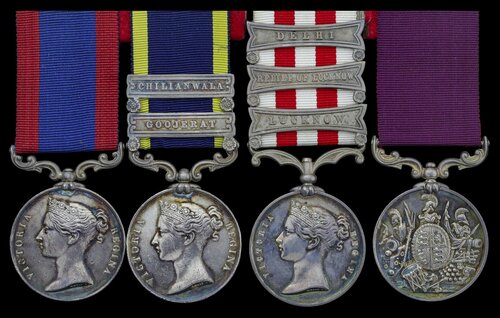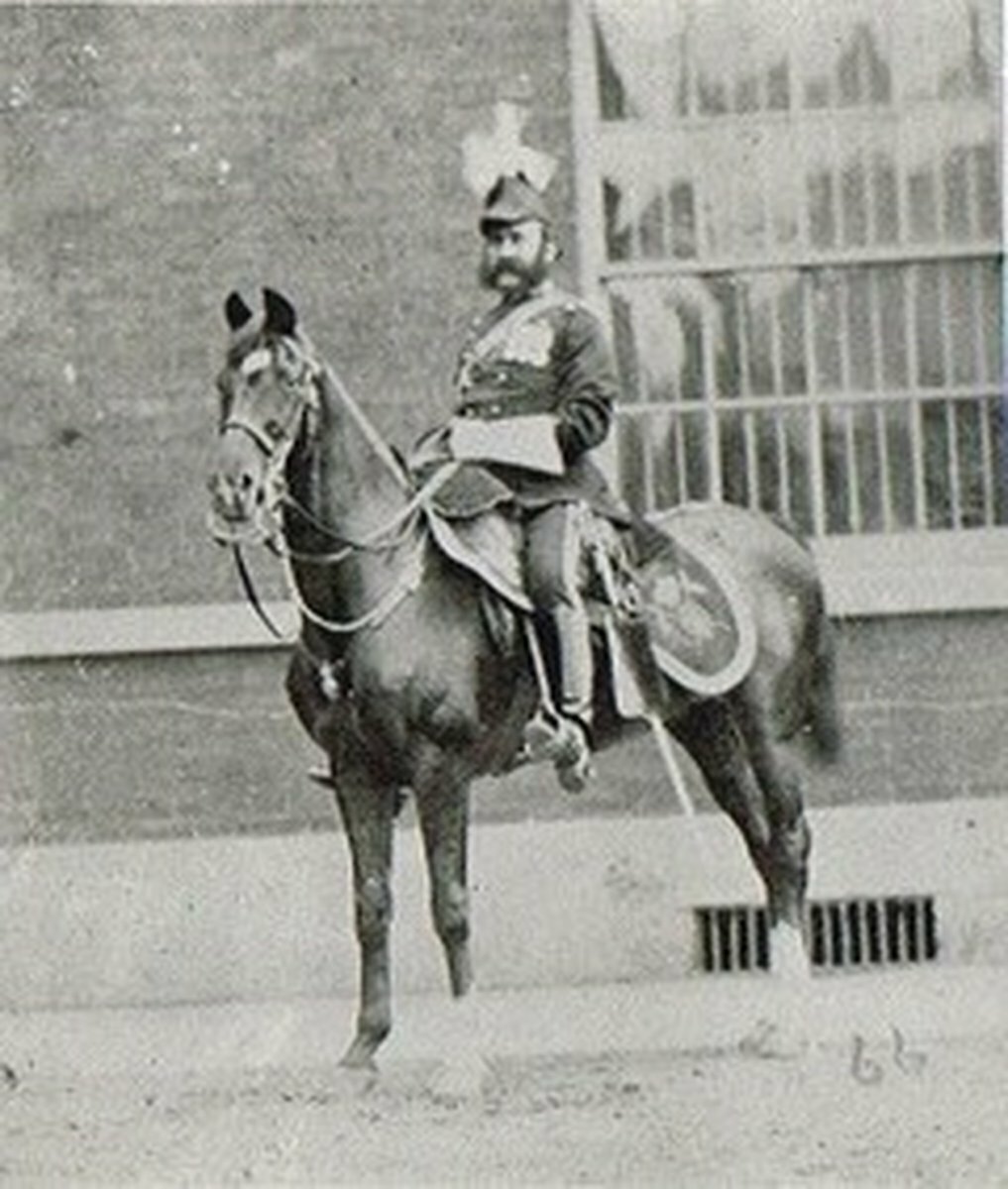Auction: 20003 - Orders, Decorations and Medals
Lot: 321
The outstanding Sikh Wars and Indian Mutiny group of four to Quartermaster G. Fuller, 9th Lancers, a popular character who recorded his military service in two remarkable journals
Sutlej 1845-46, for Sobraon, no clasp (Geo: Fuller 9th Lancers); Punjab 1848-49, 2 clasps, Chilianwala, Goojerat (G. Fuller, 9th Lancers.); Mutiny 1857-59, 3 clasps, Lucknow, Relief of Lucknow, Delhi (Serjt. Geo. Fuller, 9th Lancers.); L.S. & G.C., V.R., small letter reverse (1373 Qr. Mr. Sergt. Geo. Fuller 9th Lancers), the first and second very fine, the third and fourth good very fine (4)
George Fuller was born at Alton, Hampshire on 15 August 1826. He enlisted into the 9th (Queen's Royal) Lancers in London on 17 August 1843, aged 17. Assigned the Regimental number 1373, he sailed aboard the Judith Allan to India, arriving there on 19 October 1844. Fuller served with the 9th Lancers during the Sutlej campaign of 1845-46 (Medal). He kept a daily journal from 16 October 1845-17 April 1846, a rare first-hand account of the conflict. At the decisive Battle of Sobraon on 10 February 1846 the 9th Lancers were denied their chance for glory, and Fuller could not conceal his frustration:
'My comrades, all the men wished for a charge, as we were only sitting on our horses waiting to be shot at here. Soon after the Artillery advanced, an Aide de camp came and told Brigadier Campbell [commanding the 9th Lancers] his regiment was wanted. The trot was sounded. We advanced as far as the entrenchment, crossing a deep nullah. Orders came for us to retire. The retire was sounded and we went back to our old ground or very near.'
Fuller took part in the subsequent advance to Lahore, before the Regiment returned to Meerut on 21 March. He then served at the Battles of Chilianwala and Goojerat during the 1848-49 Punjab campaign (Medal & 2 clasps), and was promoted to Corporal in recognition of his services on 1 November 1849. He married Eleanor Moon at the Wazirabad Cantonment on 1 September 1850, in a service led by Chaplain C. Sloggett.
Advanced to Sergeant on 19 November 1851, Fuller fathered his first daughter, Frances, on the eve of the Indian Mutiny (Medal & 3 clasps). The 9th Lancers left Umballa on 17 May 1857 as part of Sir Henry Barnard's column, which advanced east along the Grand Trunk Road towards Delhi. The Regiment fought heroically at Bundlekeserai on 8 June, driving the mutineers from their entrenchments. It then took part in the three-month Siege of Delhi, frequently providing volunteers to work in the advanced batteries. After Delhi was finally stormed on 14 September, Fuller served at the Battles of Allyghur and Agra in October before joining the Second Relief of Lucknow under Lord Clyde. He was also present at the Third Battle of Cawnpore on 6 December, which resulted in the capture of Tantia Tope, the notorious rebel leader who oversaw the massacre of Wheeler's force at the nearby Satichaura Ghat on 27 June. During that atrocity around 200 British women and children were herded into the Bibigargh ('House of the Ladies') before being butchered with meat cleavers. Their blood still matted the floor when General Neill re-captured the town six months later. Neill devised a sickening punishment for the mutineers (Trevelyan 1886, 333):
'Rebels or ringleaders I make first to clean up a portion of the pool of blood, still two inches deep, in the shed where the fearful murder and mutilation of the women and children took place. To touch blood is most abhorrent to the high-caste natives. They think, by doing so, they doom their souls to perdition. Let them think so. My object is to inflict a fearful punishment for a revolting, cowardly, barbarous deed, and to strike terror into these rebels.'
After witnessing these haunting scenes, Fuller took part in the summer campaign in Oudh during 1858. He kept a daily journal during the period 20 March - 15 June 1858, and this reveals the Regiment's movements in minute detail. Every minor action or skirmish is covered. The entry for 22 April describes an encounter near Allerguuse:
'My Squadron went away to the left and round their encampments where there was tents and flags flying. We killed a pretty good number of them… I saw a fine hand to hand fight between a Pandy and one of the 2 Inf. C. this morning. It appears that the Pandy challenged any man of the troop of I.C. when one jumped off his horse and soon done him over in fine style. This was a better affair than our last one… We killed one of their leaders of the Cavalry.'
On 5 May, Fuller recorded a skirmish outside Bareilly:
'Presently a small picquet of our I.C. which was in a village on our right was seen by some of their Cavalry, who made for them to, I suppose, cut them off. But they were taken in, for their movement was noticed by us. So we soon diverged from the tope and off we went at a gallop in column of troops to meet their attack. As soon as they found out that it was us then, about and off they bolted in quick time.'
Fuller ended his diary when the Regiment reached Meerut, 50 miles north-east of Delhi, on 20 June 1858. By that time, the Mutiny was almost over. Fuller advanced to Quartermaster-Sergeant on 25 January 1859. On 2 October that year he returned home on leave, taking up residence in Dublin. He received prize money for his part in the Second Relief of Lucknow in 1862 (WO 164/59), and further prize money for the Siege of Delhi four years later. He was awarded the Long Service & Good Conduct Medal.
Fuller was commissioned Quartermaster of the 9th Lancers on 30 October 1869. The Commanding Officer of the 9th Lancers obtained special permission from Horse Guards to make this appointment, as Fuller was older than the required age of 40 (see WO31/1464). He rejoined the Regiment in India on 9 January 1872.
There are several photographs of Fuller at this period, and he also appears in an impressive photograph of the Regiment in Drill Order for an inspection by Major-General Macdonnell at Simla on 27 March 1877 (illustrated). The 9th Lancers took part in the Second Afghan War in 1878-79, but Fuller did not join them on campaign. Instead he remained at the Hill Station of Murree near Rawalpindi, in the foothills of the Himalayas. He died there (of dropsy) on 31 July 1879, aged 53, and was buried that same day by Chaplain William Ayerst. He left behind three daughters, Frances, Mary and Ada Emma.
Sold with a large folder of research, including photographs, service papers and typed copies of Fuller's two journals.
Recommended reading:
Trevelyan, Sir G., Cawnpore (London, 1886).
Subject to 20% VAT on Buyer’s Premium. For more information please view Terms and Conditions for Buyers.
Sold for
£3,800
Starting price
£1500







